大学英语四级讲座2015 听力 段落翻译解题方法
大学英语四级新题型“段落翻译”探析
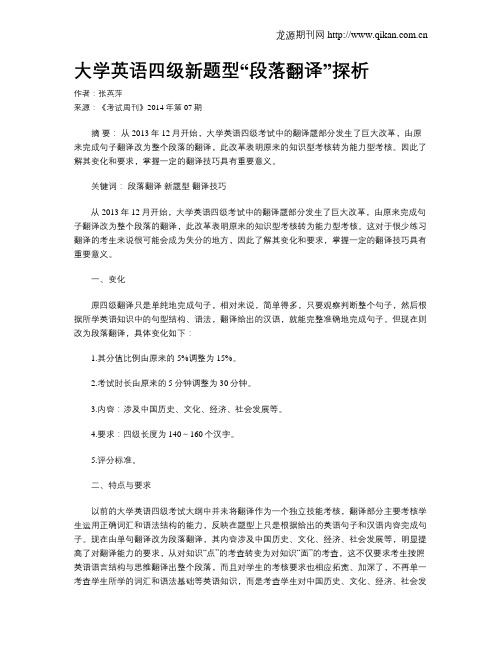
大学英语四级新题型“段落翻译”探析作者:张英萍来源:《考试周刊》2014年第07期摘要:从2013年12月开始,大学英语四级考试中的翻译题部分发生了巨大改革,由原来完成句子翻译改为整个段落的翻译,此改革表明原来的知识型考核转为能力型考核。
因此了解其变化和要求,掌握一定的翻译技巧具有重要意义。
关键词:段落翻译新题型翻译技巧从2013年12月开始,大学英语四级考试中的翻译题部分发生了巨大改革,由原来完成句子翻译改为整个段落的翻译,此改革表明原来的知识型考核转为能力型考核。
这对于很少练习翻译的考生来说很可能会成为失分的地方,因此了解其变化和要求,掌握一定的翻译技巧具有重要意义。
一、变化原四级翻译只是单纯地完成句子,相对来说,简单得多,只要观察判断整个句子,然后根据所学英语知识中的句型结构、语法,翻译给出的汉语,就能完整准确地完成句子。
但现在则改为段落翻译,具体变化如下:1.其分值比例由原来的5%调整为15%。
2.考试时长由原来的5分钟调整为30分钟。
3.内容:涉及中国历史、文化、经济、社会发展等。
4.要求:四级长度为140~160个汉字。
5.评分标准。
二、特点与要求以前的大学英语四级考试大纲中并未将翻译作为一个独立技能考核,翻译部分主要考核学生运用正确词汇和语法结构的能力,反映在题型上只是根据给出的英语句子和汉语内容完成句子。
现在由单句翻译改为段落翻译,其内容涉及中国历史、文化、经济、社会发展等,明显提高了对翻译能力的要求,从对知识“点”的考查转变为对知识“面”的考查,这不仅要求考生按照英语语言结构与思维翻译出整个段落,而且对学生的考核要求也相应拓宽、加深了,不再单一考查学生所学的词汇和语法基础等英语知识,而是考查学生对中国历史、文化、经济、社会发展、风俗习惯等的学习和了解;考查学生对合理拆分、组合句子,将汉语所承载的信息用英语表达出来的能力;考查学生对翻译技巧与方法的掌握。
总之,改革后的段落翻译是对学生进行英语知识、翻译能力、中国文化的学习等多方位、多层面的考查。
大学英语四级段落信息匹配题技巧
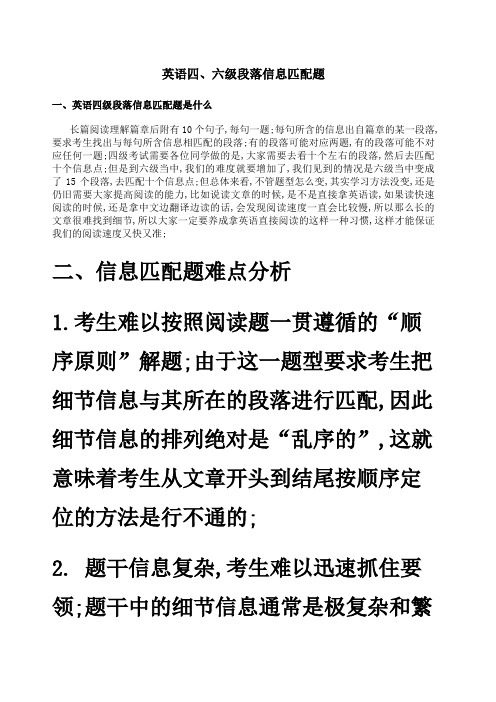
英语四、六级段落信息匹配题一、英语四级段落信息匹配题是什么长篇阅读理解篇章后附有10个句子,每句一题;每句所含的信息出自篇章的某一段落,要求考生找出与每句所含信息相匹配的段落;有的段落可能对应两题,有的段落可能不对应任何一题;四级考试需要各位同学做的是,大家需要去看十个左右的段落,然后去匹配十个信息点;但是到六级当中,我们的难度就要增加了,我们见到的情况是六级当中变成了15个段落,去匹配十个信息点;但总体来看,不管题型怎么变,其实学习方法没变,还是仍旧需要大家提高阅读的能力,比如说读文章的时候,是不是直接拿英语读,如果读快速阅读的时候,还是拿中文边翻译边读的话,会发现阅读速度一直会比较慢,所以那么长的文章很难找到细节,所以大家一定要养成拿英语直接阅读的这样一种习惯,这样才能保证我们的阅读速度又快又准;二、信息匹配题难点分析1.考生难以按照阅读题一贯遵循的“顺序原则”解题;由于这一题型要求考生把细节信息与其所在的段落进行匹配,因此细节信息的排列绝对是“乱序的”,这就意味着考生从文章开头到结尾按顺序定位的方法是行不通的;2. 题干信息复杂,考生难以迅速抓住要领;题干中的细节信息通常是极复杂和繁琐的名词短语或长难句,考生往往在寻找到合适的定位词之前,就已经被题干信息的复杂表述弄得晕头转向了;3. 考生难以寻找到合适的定位词;即使考生能够读懂题干中晦涩难懂的细节信息,但也会在寻找定位词时遇到很大障碍;因为题干提供的细节信息中往往不会出现非常明显的定位词如数字、时间、地点、人物、特殊字体和特殊符号等;即使考生能够找到一个定位词,这一定位词也通常和文章主题密切相关,会在文章中多次出现,因而也没有太大的意义;三、匹配题出题特点及应试技巧匹配类题型有很多种,常见的种类有:1人名-观点匹配;2.地名-描述匹配;3句子-句子匹配;4分类题Classification;5段落-标题匹配;6段落-细节匹配;其中前四种做题方法比较类似,而后两种相对较复杂;这里将阐述前四种题型的做题方法;1. 扭转做题思维先要扭转做题思维,不是找到句子答案所在,而是判断这句话在哪一段会出现;所以我们首要明确,考官出这个题是要考察我们什么阅读能力,我认为不是细节阅读能力,而是对文章框架思路的把握能力;2.预览题干,明确关键词该题型的解题基本思路是:先快速地将题干读一下,划出关键词;然后采用skimming和scanning的方式通读原文,匹配信息;3.快速掌握文章脉络通过阅读中心句快速掌握文章脉络;中心句一般出现在首位句,转折词如but 或者因果关系联接词如 as a result 引领的第二句,或者问句后面的答句;一般建议在找到中心句后,读一下末句,可以更精确地掌控段意;若无特别明显的中心句,首尾句的阅读也有助于理解段意;阅读过程当中,有的信息点明确可直接先去选出答案;这里我们也要明确要多看英文,掌握英文的行文思路;一般而言剑桥里的文章组织有三大类;一是按时间,如货物运输,这是最简单的; 二是按观点—原因—发展—瓶颈—措施—目标的布局来分析一件事物;三是偏科普的夹杂很多不同派别的理论,这个相对而言比较难; 4.注意字句的形式变化;在长篇阅读中寻找相关信息的难度很大程度上取决于考生对字句形式变化的辨识能力;需要注意三种变化形式:1题干只对原文中个别单词或词组进行同义改写或转述;2题干对原文中整句话进行同义改写或转述;3题干对原文中几句话或整段内容进行综合概括或推断;这就对考生的单词量、对某一单词多重释义的了解以及对句意的概括或推断能力提出了新要求; 5.注意标记;在首次阅读的过程中如果不能确定某些单句是否与该段落相匹配,最好做个记号,以便第二次阅读时更有针对性;第二次阅读的目的:一是检查已初步确定的段落与单句是否确实匹配;二是完成第一遍阅读中尚未解答的题目; 6.注意时间的合理使用,不要为确定某个细节问题而浪费大量的时间;关键词的类型1. 人名、地名和专有名词2. 一些拼写较长的词,比如:internship,competitiveness,globaliz ation,integration,sustainability,in novative,immigration等;这些词属于低频词,一般不会大篇幅地出现;利用这些词可以高效地查找匹配段落;另外,这些词有时会作为生词在文中标注出来,像internship,在原文中用斜体印刷,并以括号备注中文;我们选它做关键词,瞬间就能找到原文出处了;2. 数字,包括年代、百分比、特殊事件等;如四级样卷中的:mid-1970s, percent,20 percent,September 11等;教研君利用这些数字进行定位,测得的准确率是100%哦3. 以连字符连接的特殊词汇;如:university-based,one-child;这些词是由两个或三个单词连接的新词,一般当成形容词使用;三个单词的例子如:hard-to-grasp难以理解的;这些词也属于低频词,一般不会大篇幅出现;需要注意的是有时候我们需要将这些词拆开来定位,如one-child在原文中是没有的,原文是这样的“They often compromise by having ju st one child. ”这里的one child就不是整体作为形容词使用了;4. 研究、报告、书籍型词汇,如:report,study,books等;一般来说研究、报告等内容都是易考点,这些信息经常出现在特定的段落里,所以根据这些词汇作为关键词也很容易定位;5. 最高级,如best,worst,most等;如六级第54题,关键词之一为the best solution;然而仅凭此关键词我们可能无法迅速地找到答案,因为原文的表述是the most effective method,用的词汇是完全不一样的;这时,我们还需要增加一个关键词pension,帮助我们定位;这就提醒我们在平常的阅读中应多关注最高级出现的地方,因为它常常是考点;6. 具有特殊意义的指示性词汇;这类词汇虽然不是通常意义上的定位关键词,但其特殊含义可将考生的注意力指向原文的开头、结尾或是某个具有特殊特征的段落;这些词通常包括如下三类:①能够指示开头段的词汇如overview、introduction、initiation、main idea、definition等;②能够指示结尾段的词如overview、future、 solution、conclusion、suggestion、summary等;③能够帮助考生回原文定位的特殊词汇如rate、ratio、proportion、percentage 等词往往对应含“%”的段落;number、figure、statistical demographics等词往往对应数字集中的段落;financial、income、revenue、salary等词往往对应含诸如“$”“¥”等货币符号的段落;考生能够通过这些指示性词汇缩小回原文定位的范围,从而快速判定表1—四级样卷长篇阅读表2—六级样卷长篇阅读Passage OneUniversities Branch OutA As never before in their long history, universities have become instruments of national competition as well as instruments of peace. They are the place of the scientific discoveries that move economies forward, and the primarymeans of educating the talent required to obtain and maintain competitive advantage. But at the same time, the opening of national borders to the flow of goods, services, information and especially people has made universities a powerful force for global integration, mutual understanding and geopolitical stability.B In response to the same forces that have driven the world economy, universities have become more self-consciously global: seeking students from around the world who represent the entire range of cultures and values, sending their own students abroad to prepare them for global careers, offering courses of study that address the challenges of an interconnected world and collaborative 合作的research programs to advance science for the benefit of all humanity.C Of the forces shaping higher education none is more sweeping than the movement across borders. Over the past three decades the number of students leaving home each year to study abroad has grown at an annual rate of percent, from 800,000 in 1975 to million in 2004. Most travel from one developed nation to another, but the flow from developing to developed countries is growing rapidly. The reverse flow, from developed to developing countries, is on the rise, too. Today foreign students earn 30 percent of the doctoral degrees awarded in the United States and 38 percent of those in the United Kingdom. And the number crossing borders for undergraduate study is growing as well, to 8 percent of the undergraduates at America’s best institutions and 10 percent of all undergraduates in the . In the United States, 20 percent of the newly hiredprofessors in science and engineering are foreign-born, and in China many newly hired faculty members at the top research universities received their graduate education abroadD Universities are also encouraging students to spend some of their undergraduate years in another country. In Europe, more than 140,000 students participate in the Erasmus program each year, taking courses for credit in one of 2,200 participating institutions across the continent. And in the United States, institutions are helping place students in summer internships 实习abroad to prepare them for global careers. Yale and Harvard have led the way, offering every undergraduate at least one international study or internship opportunity—and providing the financial resources to make it possible.E Globalization is also reshaping the wayresearch is done. One new trend involves sourcing portions of a research program to another country. Yale professor and Howard Hughes Medical Institute investigator Tian Xu directs a research center focused on the genetics of human disease at Shanghai’s Fudan University, in collaboration with faculty colleagues from both schools. The Shanghai center has 95 employees and graduate students working in a 4,300-square-meter laboratory facility. Yale faculty, postdoctors and graduate students visit regularly and attend videoconference seminars with scientists from both campuses. The arrangement benefits both countries; Xu’s Yale lab is more productive, thanks to the lower costs of conducting research in China, and Chinese graduate students, postdoctors and faculty get on-the-job training from a world-class scientist and his . team.F As a result of its strength in science, the United States has consistently led the world in the commercialization of major new technologies, from the mainframe computer and the integrated circuit of the 1960s to the Internet infrastructure 基础设施and applications software of the 1990s. The link between university-based science and industrial application is often indirect but sometimes highly visible: Silicon Valley was intentionally created by Stanford University, and Route 128 outside Boston has long housed companies spun off from MIT and Harvard. Around the world, governments have encouraged copying of this model, perhaps most successfully in Cambridge, England, where Microsoft and scores of other leading software and biotechnology companies have set up shop around the university.G For all its success, the United Statesremains deeply hesitant about sustaining the research-university model. Most politicians recognize the link between investment in science and national economic strength, but support for research funding has been unsteady. The budget of the National Institutes of Health doubled between 1998 and 2003, but has risen more slowly than inflation since then. Support for the physical sciences and engineering barely kept pace with inflation during that same period. The attempt to make up lost ground is welcome, but the nation would be better served by steady, predictable increases in science funding at the rate of long-term GDP growth, which is on the order of inflation plus 3 percent per year.H American politicians have great difficulty recognizing that admitting more foreign students can greatlypromote the national interest by increasing international understanding. Adjusted for inflation, public funding for international exchanges and foreign-language study is well below the levels of 40 years ago. In the wake of September 11, changes in the visa process caused a dramatic decline in the number of foreign students seeking admission to . universities, and a corresponding surge in enrollments in Australia, Singapore and the . Objections from American university and business leaders led to improvements in the process and a reversal of the decline, but the United States is still seen by many as unwelcoming to international students.I Most Americans recognize that universities contribute to the nation’s well-being through their scientific research, but many fear that foreign students threaten Americancompetitiveness by taking their knowledge and skills back home. They fail to grasp that welcoming foreign students to the United States has two important positive effects: first, the very best of them stay in the States and—like immigrants throughout history—strengthen the nation; and second, foreign students who study in the United States become ambassadors for many of its most cherished 珍视values when they return home. Or at least they understand them better. In America as elsewhere, few instruments of foreign policy are as effective in promoting peace and stability as welcoming international university students.1. American universities prepare their undergraduates for global careers by giving them chances for international study or internship.2. Since the mid-1970s, the enrollment ofoverseas students has increased at an annual rate of percent.3. The enrollment of international students will have a positive impact on America rather than threaten its competitiveness.4. The way research is carried out in universities has changed as a result of globalization.5. Of the newly hired professors in science and engineering in the United States, twenty percent come from foreign countries.6. The number of foreign students applying to . universities decreased sharply after September 11 due to changes in the visa process.7. The . federal funding for research has been unsteady for years.8. Around the world, governments encourage the model of linking university-based science and industrialapplication.9. Present-day universities have becomea powerful force for global integration.10. When foreign students leave America, they will bring American values back to their home countries.Passage TwoInto the unknownA Until the early 1900s nobody thought much about the whole populations getting older. UN had the foresight to convene a “world assembly on ageing” back in 1982, but that came and went. By 1994 the World Bank had noticed that something big was happening. In a report entitled “Averting the Old Age Crisis”, itargued that pension arrangements in most countries were unsustainable.B For the next ten years a succession of books, mainly by Americans, surrounded by the alarm. They had titles like Young vs. Old, Gray Dawn and The Coming Generational Storm, and their message was blunt: health-care systems were heading for the rocks, pensioners were taking young people to the cleaners, and soon there would be intergenerational warfare.C Since then the debate has become less emotional, not least because alot more is known about the subject. Books, conferences and research papers have multiplied. International organizations such as the OECD and the EU issue regular reports. Population ageing is on every agenda, from G8 economic conferences to NATO summits. The World Economic Forum plans to consider the future of pensions and health care at its prestigious Davos conference early next year. The media, including the newspaper, are giving the subject extensive coverage.D Whether all that attention hastranslated into sufficient action is another question. Governments in rich countries now accept that their pension and health-care promises will soon become unaffordable, and many of them have embarked on reforms, but so far only timidly. That is not surprising: politicians with an eye on the next election will hardly rush to introduce unpopular measures that may not bear fruit for years, perhaps decades.E The outline of the changes needed is clear. To avoid fiscal 财政的meltdown, public pensions andhealth-care provision will have to be reined back severely and taxes may have to go up. By far the most effective method to restrain pension spending is to give people the opportunity to work longer, because it increases tax revenues and reduces spending on pensions at the same time. It may even keep them alive longer. John Rother, the AARP’s head of policy and strategy, points to studies showing that other things being equal, people who remain at work have lower death rates than their retired peers.F Younger people today mostly accept that they will have to work for longer and that their pensions will be less generous. Employers still need to be persuaded that older workers are worth holding on to. That may be because they have had plenty of younger ones to choose from, partly thanks to the post-war baby-boom and partly because over the past few decades many more women have entered the labor force, increasing employers’ choice. But the reservoir of women able and willing to take up paid work is running low, and thebaby-boomers are going grey.G In many countries immigrants have been filling such gaps in the labor force as have already emerged and remember that the real shortage is still around ten years off. Immigration in the developed world is the highest it has ever been, and it is making a useful difference. In still-fertile America it currently accounts for about 40% of total population growth, and in fast-ageing Western Europe for about 90%.H On the face of it, it seems the perfect solution. Many developingcountries have lots of young people in the need of jobs, many rich countries need helping hands that will boost tax revenues and keep up economic growth. But over the next few decades labor forces in rich countries are set to shrink so much that inflows of immigrants would have to increase enormously to compensate: to at least twice their current size in western Europe’s most youthful countries, and three times in the older ones. Japan would need a large multiple of the few immigrants it has at present. Public opinion polls show that peoplein most rich countries already think that immigration is too high. Further big increases would be politically unfeasible.I To tackle the problem of ageing populations at its ro ot, “old” countries would have to rejuvenate 使年轻themselves by having more of their own children. A number of them have tried, some more successfully than others. But it is not a simple matter of offering financial incentives or providing more child care. Modern urban life in rich countries is not well adapted to largefamilies. Women find it hard to combine family and career. They often compromise by having just one child. J And if fertility in ageing countries does not pick up It will not be the end of the world, at least not for quite a while yet, but the world will become a different place. Older societies may be less innovative and more strongly disinclined to take risks than younger ones. By 2025 at the latest, about half the voters in America and most of those in western European countries will be over 50—and older people turn out to votein much greater numbers than younger ones. Academic studies have found no evidence so far that older voters have used their power at the ballot box to push for policies that specifically benefit them, though if in future there are many more of them they might start doing so.K Nor is there any sign of the intergenerational warfare predicted in the 1990s. After all, older people themselves mostly have families. In a recent study of parents and grown-up children in 11 European countries, Karsten Hank of Mannheim Universityfound that 85% of them lived within 25km of each other and the majority of them were in touch at least once a week.L Even so, the shift in the centre of gravity to older age groups is bound to have a profound effect on societies, not just economically and politically but in all sorts of other ways too. Richard Jackson and Neil Howe of America’s CSIS, in a thoughtful book called The Graying of the Great Powers, argue that, among other things, the ageing of the developed countries will have a number of serious securityimplications.M For example, the shortage of young adults is likely to make countries more reluctant to commit the few they have to military service. In the decades to 2050, America will find itself playing an ever-increasing role in the developed world’s defense effort. Because America’s population will still be growing when that of most other developed countries is shrinking, America will be the only developed country that still matters geopolitically 地缘政治上.N There is little that can be done to stop population ageing, so the world will have to live with it. But some of the consequences can be alleviated. Many experts now believe that given the right policies, the effects, though grave, need not be catastrophic. Most countries have recognized the need to do something and beginning to act.O But even then there is no guarantee that their efforts will work. What is happening now is historically unprecedented. The director of Economics and Demography of Ageing atthe University of California, Berkeley, puts it briefly and clearly: “We don’t really know what population ageing will be like, because nobody has done it yet.” 1. Employers should realize it is important to keep older workers in the workforce.2. A recent study found that most old people in some European countries had regular weekly contact with their adult children.3. Few governments in rich countries have launched bold reforms to tackle the problem of population ageing.4. In a report published some 20 years ago, the sustainability of old-age pension systems in most countries was called into doubt.5. Countries that have a shortage of young adults will be less willing to send them to war.families are more common in ageing societies due to the stress of urban life and the difficulties of balancing families and cancer.7. A series of books, mostly authored by Americans, warned of conflicts between the older and younger generations.pared with younger ones, older societies tend to be less innovative and take fewer risks.9. The best solution to the pension crisis is to postpone the retirement age.10. Immigration as a means to boost the shrinking labour force may meet with resistance in some rich countries.。
四级听力长对话技巧【可编辑全文】

以下总结家庭日常生活类话题经常出现的句子/ 句 型:
What form of transport do you prefer to use? What are your opinions about traffic problems? There is a problem with ... I am sorry about this inconvenience. How can we afford to buy ...? We can pay a little on ... I’ve been told you might have a vacant room. Do you want to share with any roommates or live
以下总结休闲时光类话题经常出现的句子/ 句型: I am packed and ready to leave. I can’t remember which bag it’s in. I have planned to ... I can give you a 10% discount. I’ll have to charge you 100 pounds for the night. I am going to visit ... I have also traveled a bit. It is less crowded and hotels cost less. I love train travel. Would you recommend some scenic spots for us to see
以2006年12月Conversation Two为例: 8’00
(二) 听时抓“点”
有了充分的听前预测,听时的主要任务就是抓住考 点,且掌握如下两个原则:
(英语四级经验)大学英语四级翻译经验总结

大学英语四级翻译经验总结在英语四级考试中,时间是非常的紧张的,可是面对如此大的题量,很多考生都会选择性的放弃一些题目,而翻译是首选,因为翻译占据的题量小,分值少。
以下是我为大家整理的大学英语四级翻译经验总结,感谢您的欣赏。
段落翻译常见考点总结1.固定搭配固定搭配不仅是翻译中的最为核心的考点,也是四六级考试中其他试题局部出现密度最高的知识点,尤其应该引起考生的高度重视。
翻译中一句话除了有一定的语法外,更要有固定搭配来完整整个句子,保证句子的正确无误,比方说名词与动词搭配,形容词与名词搭配,动词与副词的修饰关系,名词与介词搭配,更为重要的是常见的固定词组以及固定表达,这次都可能成为段落翻译出题的重点。
2.核心语法语法知识虽然看起来很枯燥,但是在翻译和写作两个局部的运用却是最多的,翻译这局部语法考点大多数是以前词汇语法考题考点的重现和转移,这一点要引起同学的重视,尽管句子翻译现在不考了,但是段落翻译还是由一个个单独的句子组成,所以大体上它们有些考点是一致的。
核心语法考点最重要的虚拟语气,其次是倒装结构、从句知识、倒装结构、非谓语动词等,这些只是从中学时我们就接触过了,也应该了解它们在英语中的重要性。
3.核心动词以及动词短语的考查动词可以说是英语中运用最为灵活的一类词,动词可以按照含义及它们在句中的作用分成四类,即行为动词(也称实义动词)、连系动词、助动词和情态动词,这些动词又可以细分出很多知识点,运用的时候要根据句子的实际情况加以筛选,所以考生一定要重点掌握。
大学英语四级翻译备考技巧Q1:考试的时候翻译题会给难词的hintsA1:会给术语的hints。
比方:茶艺(这是中国文化的一个术语,会给提示词。
)Q2:六级翻译,这个真心不知怎么办A2:能翻多少翻多少,采分点可能是一些关键信息。
同时提醒同学可以去寻求专业指导,跟着老师学习!Q3:我的语法很烂,句子语法无法分辨对错,想问问翻译题型的标准是什么A3:段落翻译的建议是考前提高可能性比拟小,但思路可以更清晰!先认真把中文中间自己能翻对的单词、短语翻对,然后再往中间加些动词或修饰语连接起来就行。
英语四级技巧优秀3篇

英语四级技巧优秀3篇大学英语四级考试应试小技巧篇一1、听力考试的应试方法①听前,读选项,合理猜题。
听力正式播放前会有三至五分钟试音及读题的时间,利用这一段时间来浏览一遍题目,并根据选项合理推测题目的走向,做到心中有数,实在没有听清也可以根据推测猜题。
②听时,听关键词。
利用在预测中得到的潜在信息和读音的快慢、高低等声音手段抓好听音的重点,并利用符号、图示等方法迅速记录要点,促进有效记忆。
要养成眼耳并用的习惯,一边用耳听,一边用眼浏览答案,把捕捉信息与选择答案结合起来同时进行。
在对话或短文的试题中,如有做不出来的题目,请先空在哪里,集中精力听好下一题。
③听后,回忆,确定。
听完录音后要迅速回忆整理所听懂的内容,并根据提问来选择或检验答案,要严格控制答题时间,在短暂的10秒钟左右的时间内作出自信的反应。
2、从书面选择项中寻找潜在的信息--预测①正式放音前有一段听声音的小乐曲,播放时间为2分40秒,这个时间可以利用②在每一个section开始时都有一段介绍试题做法的directions,可以利用这一段时间③在录音播放每道题目前,将注意力再次记住那个到该题的书面选择项中,作具体的预测分析④在小对话每两题约15秒的空隙时间中,用10秒钟答完本题,用5秒钟速读下一道题的四个选择项,预测试题内容和问题,做好听音准备。
这样依此类推,环环紧扣,直到听力考试结束。
3、捕捉对话中的重点信息①听清时间、地点以及展开对话的主人公②转折性指示词,如but,yet,however,besides等。
一般这种词语的前半部分可以不听但是后半部分比较重要。
③弄清否定的含义,弄清是具体的否定还是双重否定等。
4、把握对话中的关键词——最能反映某种场所、环境特征或职业特征的词汇①有关学校的常用词和词组:scholarship,credits,degree,day student,boarder,auditor,required course,optional course,mark,grade,excellent,good,pass,failure,academic,record,diploma,thesis,termpaper,teaching program,individual study.②有关银行、邮局的常用词Check,cash,deposit,currency,bond,passbook,interest rate,saving account,stamps counter,ordinary letter,overweight,air mail,registered letter,postal remittance,official correspondence,parcel from,ordinary telegram,number engaged,to hang up.③有关机场、车站的常用词Airline,civil aviation,departure,time,take off,to board a plane,flight,booking office,express trains,platform,waiting room,flight coupon,check-in procedure,passport,visa,running late,car attendant,make reservation.④有关参观、商店的常用词Dinner,snack,dessert,refreshments,cold dish,soup,Chinese food,order,menu,banquet,softdrink,fixed prices,bargain,out of style,fashion, in stock,necessities,check-out stand,cash or charge?5、如何听好长对话1)在听录音的时候养成做笔记的习惯,笔记主要是记下相关的关键信息。
大学英语四级考试翻译测试解题步骤及备考建议
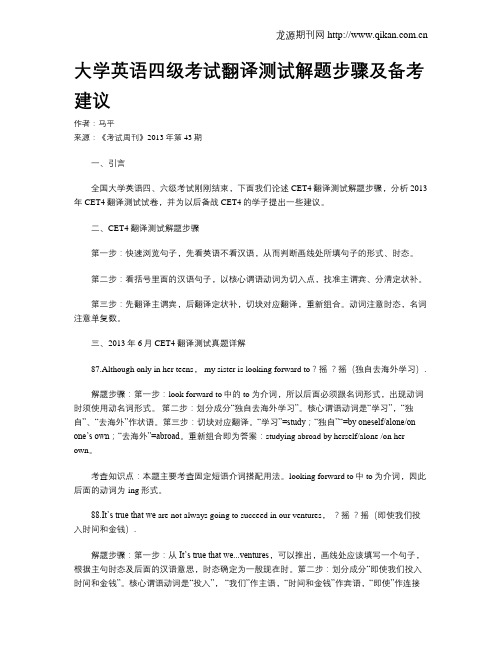
大学英语四级考试翻译测试解题步骤及备考建议作者:马平来源:《考试周刊》2013年第43期一、引言全国大学英语四、六级考试刚刚结束,下面我们论述CET4翻译测试解题步骤,分析2013年CET4翻译测试试卷,并为以后备战CET4的学子提出一些建议。
二、CET4翻译测试解题步骤第一步:快速浏览句子,先看英语不看汉语,从而判断画线处所填句子的形式、时态。
第二步:看括号里面的汉语句子,以核心谓语动词为切入点,找准主谓宾、分清定状补。
第三步:先翻译主谓宾,后翻译定状补,切块对应翻译,重新组合。
动词注意时态,名词注意单复数。
三、2013年6月CET4翻译测试真题详解87.Although only in her teens, my sister is looking forward to?摇?摇(独自去海外学习).解题步骤:第一步:look forward to中的to为介词,所以后面必须跟名词形式,出现动词时须使用动名词形式。
第二步:划分成分“独自去海外学习”。
核心谓语动词是“学习”,“独自”、“去海外”作状语。
第三步:切块对应翻译。
“学习”=study;“独自”“=by oneself/alone/on one’s own;“去海外”=abroad。
重新组合即为答案:studying abroad by herself/alone /on her own。
考查知识点:本题主要考查固定短语介词搭配用法。
looking forward to中to为介词,因此后面的动词为-ing形式。
88.It’s true that we are not always going to succeed in our ventures,?摇?摇(即使我们投入时间和金钱).解题步骤:第一步:从It’s true that we...ventures,可以推出,画线处应该填写一个句子,根据主句时态及后面的汉语意思,时态确定为一般现在时。
全国大学英语四级翻译 CET4 四级翻译新题型技巧讲解

长嗟短叹 -- sighing deeply 发号施令-- issue orders 土崩瓦解-- fall apart 两面三刀-- two-faced tactics
3. 词类转换
词类变形和转换,是英语语言的一个很重要的特 点,尤其是名词、动词、形容词这三种最主要的 词类。
译直)译与意译相互关联,互为补充,两种译法可以并用
二、 汉译英的基本技巧
1. 增词 为了充分传达原文含义,必须增补词语,以求达意.
北京是中国的政治、文化中心。这里你可以游览万 里长城、故宫、颐和园等。
Beijing is a political and cultural center that offers some scenic attractions: the Great Wall, the Forbidden City, the Summer Palace etc.
Practice Please.
省名词
见到自己的故乡,他想起了童年的情景。
The sight of his native place called back his
childhood.
(省动词)
他连续讲了两小时的法语,没有出现任何错误。 He has been speaking in French for two hours
汉译英的 基本技巧
一、翻译的基本方法: 直译 & 意译
直译:保持原文内容、又保持原文形式,基 本保留原有句子结构,不是死译。
意译:只保持原文内容、不保持原文形式, 更多考虑英语的特点。
如: 我们的朋友遍天下。 Our friends are all over the world. (直译) We have friends all over the world.(意
英语四级听力答题方法
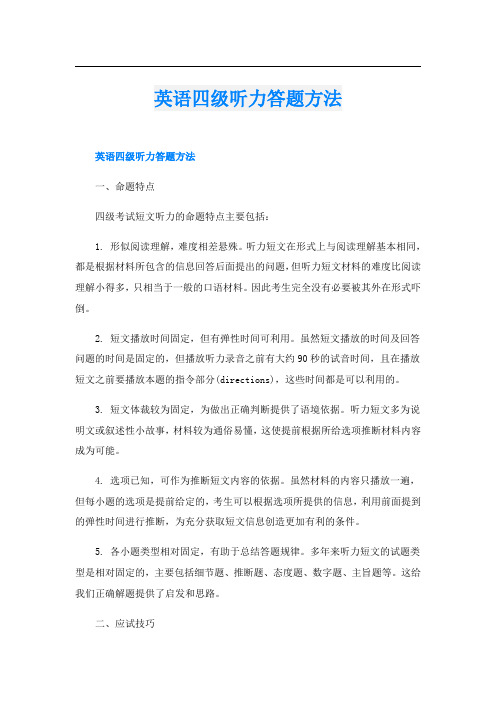
英语四级听力答题方法英语四级听力答题方法一、命题特点四级考试短文听力的命题特点主要包括:1. 形似阅读理解,难度相差悬殊。
听力短文在形式上与阅读理解基本相同,都是根据材料所包含的信息回答后面提出的问题,但听力短文材料的难度比阅读理解小得多,只相当于一般的口语材料。
因此考生完全没有必要被其外在形式吓倒。
2. 短文播放时间固定,但有弹性时间可利用。
虽然短文播放的时间及回答问题的时间是固定的,但播放听力录音之前有大约90秒的试音时间,且在播放短文之前要播放本题的指令部分(directions),这些时间都是可以利用的。
3. 短文体裁较为固定,为做出正确判断提供了语境依据。
听力短文多为说明文或叙述性小故事,材料较为通俗易懂,这使提前根据所给选项推断材料内容成为可能。
4. 选项已知,可作为推断短文内容的依据。
虽然材料的内容只播放一遍,但每小题的选项是提前给定的,考生可以根据选项所提供的信息,利用前面提到的弹性时间进行推断,为充分获取短文信息创造更加有利的条件。
5. 各小题类型相对固定,有助于总结答题规律。
多年来听力短文的试题类型是相对固定的,主要包括细节题、推断题、态度题、数字题、主旨题等。
这给我们正确解题提供了启发和思路。
二、应试技巧结合听力短文的命题特点,我们可总结出如下解题步骤:首先,浏览已知选项,推断问题的内容和短文大意。
在播放短文之前,我们可以利用弹性时间浏览各小题选项,推断短文的体裁和大致内容,为播放短文时充分获取信息做准备。
另外,也可据此推断问题的类型甚至内容以便听录音时更有针对性。
其次,手眼脑并用,记录关键信息。
播放短文录音期间要听记兼顾,以听为主。
一篇短文就是一个信息群,完全靠大脑记忆所有的信息往往是很困难的。
因此我们应该把获取的主要信息有选择性地记录下来,特别是有关细节,为做出正确选择做准备。
需要特别注意的是这时"听"应该是第一位的,千万不要因为记录前面的信息而漏听后面的信息。
大学英语四级段落翻译技巧
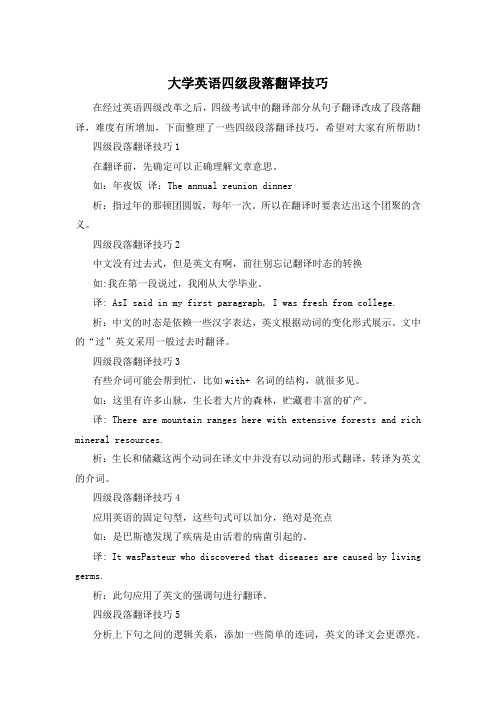
大学英语四级段落翻译技巧在经过英语四级改革之后,四级考试中的翻译部分从句子翻译改成了段落翻译,难度有所增加,下面整理了一些四级段落翻译技巧,希望对大家有所帮助!四级段落翻译技巧1在翻译前,先确定可以正确理解文章意思。
如:年夜饭译:The annual reunion dinner析:指过年的那顿团圆饭,每年一次。
所以在翻译时要表达出这个团聚的含义。
四级段落翻译技巧2中文没有过去式,但是英文有啊,前往别忘记翻译时态的转换如:我在第一段说过,我刚从大学毕业。
译: AsI said in my first paragraph, I was fresh from college.析:中文的时态是依赖一些汉字表达,英文根据动词的变化形式展示。
文中的“过”英文采用一般过去时翻译。
四级段落翻译技巧3有些介词可能会帮到忙,比如with+ 名词的结构,就很多见。
如:这里有许多山脉,生长着大片的森林,贮藏着丰富的矿产。
译: There are mountain ranges here with extensive forests and rich mineral resources.析:生长和储藏这两个动词在译文中并没有以动词的形式翻译,转译为英文的介词。
四级段落翻译技巧4应用英语的固定句型,这些句式可以加分,绝对是亮点如:是巴斯德发现了疾病是由活着的病菌引起的。
译: It wasPasteur who discovered that diseases are caused by living germs.析:此句应用了英文的强调句进行翻译。
四级段落翻译技巧5分析上下句之间的逻辑关系,添加一些简单的连词,英文的译文会更漂亮。
如:汽油贵得惊人,我们就很少用车。
译: Becausethe price of gasoline was fantastically high, we seldom used our cars.析:在原文中并没有出现表示原因类的词汇,但是在译文中根据两个句子之间的逻辑关系添加了表示原因的从句连词。
CET4翻译专题讲座
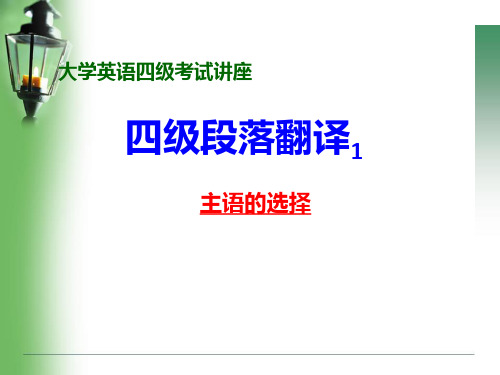
According to Xinhua news agency, the food wasted by Chinese people every year is equal to about 50 million tons of grain. What is more astonishing is that college students waste twice as much food as the national average. To reduce food waste, many college canteens have taken various measures. By adopting measures like improving the food quality and offering small portions, they encourage students to join in the “ eat-up” campaign. These measures have greatly improved students’ awareness of food conservation. Many students said they would do their bit to eliminate food waste.
大学英语四级考试讲座
四级段落翻译1
主语的选择
主语是否为动作的实施者? 现在全世界各地都在学习中国功夫。 Nowadays, Chinese kungfu is being learned all across the world. 中国人交友,最重要的原则是诚和信。 Chinese people try to maintain two most important principles in friendship: sincerity and faithfulness.
大学英语四级考试段落翻译题型解析
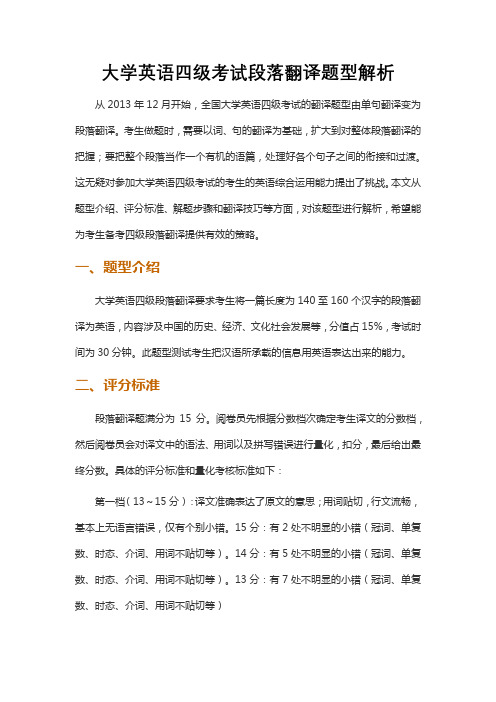
大学英语四级考试段落翻译题型解析从2013年12月开始,全国大学英语四级考试的翻译题型由单句翻译变为段落翻译。
考生做题时,需要以词、句的翻译为基础,扩大到对整体段落翻译的把握;要把整个段落当作一个有机的语篇,处理好各个句子之间的衔接和过渡。
这无疑对参加大学英语四级考试的考生的英语综合运用能力提出了挑战。
本文从题型介绍、评分标准、解题步骤和翻译技巧等方面,对该题型进行解析,希望能为考生备考四级段落翻译提供有效的策略。
一、题型介绍大学英语四级段落翻译要求考生将一篇长度为140至160个汉字的段落翻译为英语,内容涉及中国的历史、经济、文化社会发展等,分值占15%,考试时间为30分钟。
此题型测试考生把汉语所承载的信息用英语表达出来的能力。
二、评分标准段落翻译题满分为15分。
阅卷员先根据分数档次确定考生译文的分数档,然后阅卷员会对译文中的语法、用词以及拼写错误进行量化,扣分,最后给出最终分数。
具体的评分标准和量化考核标准如下:第一档(13~15分):译文准确表达了原文的意思;用词贴切,行文流畅,基本上无语言错误,仅有个别小错。
15分:有2处不明显的小错(冠词、单复数、时态、介词、用词不贴切等)。
14分:有5处不明显的小错(冠词、单复数、时态、介词、用词不贴切等)。
13分:有7处不明显的小错(冠词、单复数、时态、介词、用词不贴切等)第二档(10~12分):译文基本上表达了原文的意思;文字通顺、连贯,无重大语言错误。
12分:有一个严重错句11分:有3处明显语言错句。
10分:有4处明显语言错误。
第三档(7~9分):译文勉强表达了原文的意思;用词欠准确,语言错误相当多,其中有些是严重语言错误。
9分:5个句子正确或基本正确。
8分:4个句子正确或基本正确。
7分:3个句子正确或基本正确。
第四档(4~6分):译文仅表达了一小部分原文的意思;用词不准确,有相当多的严重语言错误。
6分:内容基本表达,有两个句子正确。
5分:一个句子正确。
大学英语备课资料四级段落翻译及技巧课件
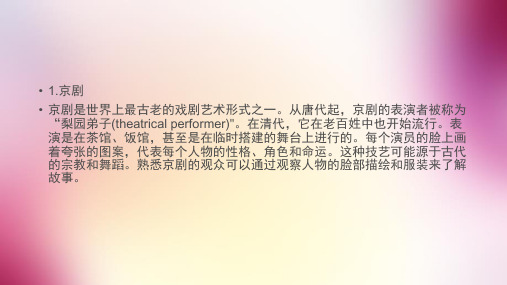
• 参考翻译:
• Beijing opera is one of the oldest opera art forms inthe world.Since the Tan g Dynasty,performers ofBeijing opera were referred to as "theatricalperfor mers".During the Qing Dynasty,it becamefashionable among ordinary peo ple.Performanceswere watchcd in tearooms, restaurants, and even on ma keshift stages.Exaggerated designs arepainted on cach performer's face t o symbolize a characters personality,role,and fate.Thistechnique may have originated from ancient religions and dance.Audiences who are familiar wi ththe opera can know the story by observing the characters' facial painting s as well as their costumes.
• 1.京剧
• 京剧是世界上最古老的戏剧艺术形式之一。从唐代起,京剧的表演者被称为 “梨园弟子(theatrical performer)"。在清代,它在老百姓中也开始流行。表 演是在茶馆、饭馆,甚至是在临时搭建的舞台上进行的。每个演员的脸上画 着夸张的图案,代表每个人物的性格、角色和命运。这种技艺可能源于古代 的宗教和舞蹈。熟悉京剧的观众可以通过观察人物的脸部描绘和服装来了解 故事。
大学英语四级翻译解题方法

大学英语四级汉译英方法总结一、汉译英简介在四级新题型考试中,翻译题所占分值为5%。
由5 个句子构成,要求考生将句子的一部分由中文翻译成英文。
它考察的内容主要包含两部分,一是意群的表达,二是句法。
汉译英主要的考点有:固定构造的用法、词性的变换、语态之间的变换、长短句之间的转变和词语选择的适合性。
二、汉译英解题步骤知音知彼,百战百胜。
若想在这一崭新的题型上得高分,考生一定第一透辟地认识它的形式和要求,摸清命题人的思路,有针对性地复习、练习。
大学英语四级考试的汉译英部分包含五个句子,每句话都由一部分汉语和一部分英语构成,要求考生将此中的汉语部分翻译成英语,与所给英语部分构成一个完好的句子。
针对这部分题型的特色和中国学生在翻译训练中常犯的错误,我们为考生拟订了做豪杰译英的四步法。
(一)通读全句,确立语法成分汉译英题型中的汉语和英语部分共同构成了一个完好的达意单位,不可以将其割裂开来。
同时,因为两种语言之间的语法构造相去甚远,考生不该当将汉语部分直接翻译成英语,而是要第一阅读整个句子,确立要求翻译的部分在整个英语句子中的语法成分。
看比如:着窗外(她目不斜视地),she told us that our friend Tom had died in the air crash .分析:好多学生看到给出的汉语部分是一个完好的主谓句,就想自然地将其翻译成一个英文的简单句。
但认真研究逗号此后的英文部分我们就会发现,这一部分才是句子的骨干。
因为英文中的逗号没有连结两个分句的功能,而本句逗号后边没有接,所以划部分不是一个句子,而是一个状成分。
由此可知,我必使用非构或独立主格构。
可接受的答案包括:Keeping her eyes fixed out of the window ;Staring out of the win-low ;With her eyes fixed out the window ;Her eyes fixed out of the window 等。
英语四级各类题型答题技巧
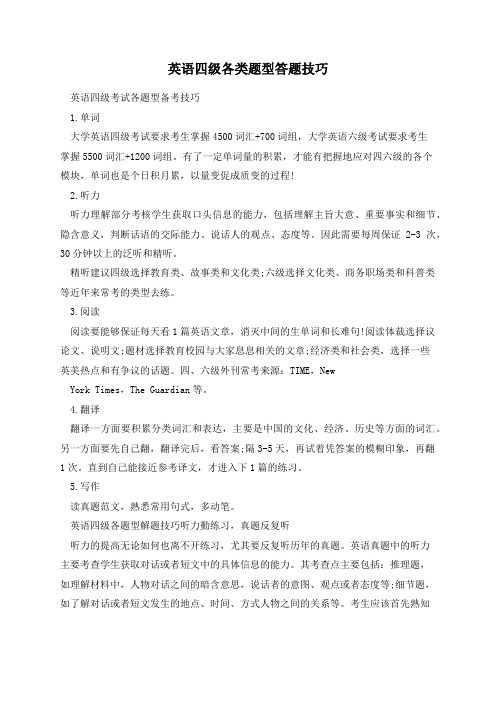
英语四级各类题型答题技巧英语四级考试各题型备考技巧1.单词大学英语四级考试要求考生掌握4500词汇+700词组,大学英语六级考试要求考生掌握5500词汇+1200词组。
有了一定单词量的积累,才能有把握地应对四六级的各个模块,单词也是个日积月累,以量变促成质变的过程!2.听力听力理解部分考核学生获取口头信息的能力,包括理解主旨大意、重要事实和细节、隐含意义,判断话语的交际能力、说话人的观点、态度等。
因此需要每周保证2-3次,30分钟以上的泛听和精听。
精听建议四级选择教育类、故事类和文化类;六级选择文化类、商务职场类和科普类等近年来常考的类型去练。
3.阅读阅读要能够保证每天看1篇英语文章,消灭中间的生单词和长难句!阅读体裁选择议论文、说明文;题材选择教育校园与大家息息相关的文章;经济类和社会类,选择一些英美热点和有争议的话题。
四、六级外刊常考来源:TIME,NewYork Times,The Guardian等。
4.翻译翻译一方面要积累分类词汇和表达,主要是中国的文化、经济、历史等方面的词汇。
另一方面要先自己翻,翻译完后,看答案;隔3-5天,再试着凭答案的模糊印象,再翻1次。
直到自己能接近参考译文,才进入下1篇的练习。
5.写作读真题范文,熟悉常用句式,多动笔。
英语四级各题型解题技巧听力勤练习,真题反复听听力的提高无论如何也离不开练习,尤其要反复听历年的真题。
英语真题中的听力主要考查学生获取对话或者短文中的具体信息的能力。
其考查点主要包括:推理题,如理解材料中,人物对话之间的暗含意思,说话者的意图、观点或者态度等;细节题,如了解对话或者短文发生的地点、时间、方式人物之间的关系等。
考生应该首先熟知这些考点,然后在考试期间,能够有所侧重,有的放矢。
这就需要考生在平时的练习中熟悉真题中英语听力部分的节奏、语音、语调,以便迎接未来听力考试的检验。
阅读限时练阅读部分在考试中占的比例较大,题量也相对较大,很多考生经常会面临考试时间紧张的问题,这就需要大家在冲刺阶段,针对阅读理解进行一些限时性练习,时间限定在25分钟之内,这样可以在营造真实考试考场氛围的同时,还能保证在未来考场上,考生能够拥有充沛的精力和集中力来对付考试。
大学英语四级第2课段落翻译1
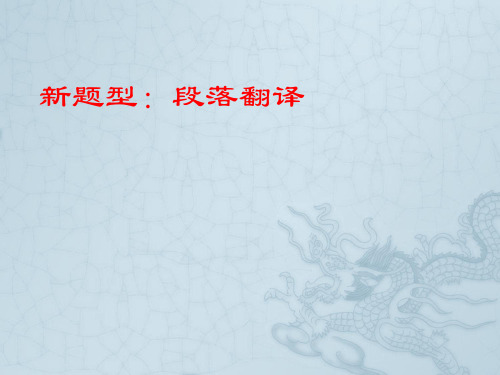
2010-6 京沪高速铁路建成之后,京沪间长期存在
的运输能力紧张状况将在根本上得到解决。
When completed, the high-speed railway will ease the long existing traffic pressure between Beijing and Shanghai.
越来越多的博物馆免费向公众开放。
More and more museums have been open to public for free. (直译)
More and more museums have offered free admission to public. (意译)
(An increasing number of …)
直译以严格意义上的忠实为宗旨,意译则 更多考虑英语的特点。总之,选择直译还 是意译,应该根据文章具体需要而定,两 种译法可以并用。
直译与意译相互关联、互为补充。通过对 直译与意译二者关系的正确理解,我们可以 更多地认识到什么时候采用直译、什么时 候采用意译,以及在运用直译与意译的时 候所应该掌握的技巧、遵循的原则和应该 注意的问题,最终达到提高翻译能力及水 平的目的。
例子:这是黄河滩上的一幕。
This is a scene taking place on the shore of the Yellow River.
(3)词的减省
所谓词的减省,就是翻译时,把原文 中一些仅仅为了语法上的需要而存在的词、 词组加以适当省略,从而达到译文通顺、 意思完整及句子精炼的目的。汉语中重复 的部分可以是主语、谓语、宾语、表语、 定语等,在译成英语时需适当删减,以保 持句子的通顺。
2.状语的位置
2015年12月大学英语四级翻译真题及答案(一套)

2015年12月大学英语四级翻译真题及答案(一套)1、中国父母往往过于关注孩子的,以至于不要他们帮忙做家务。
他们对孩子的首要要求就是努力学习。
考得好,能上名牌大学。
他们相信这是为孩子好。
因为在中国这样竞争激烈的社会里,只有成绩好才能保证前途光明。
中国父母还认为,如果孩子能在社会上取得大的成就,父母就会受到尊重。
因此,他们愿意牺牲自己的时间、爱好和兴趣,为孩子提供更好的条件。
Chinese parents tendto pay so much attention to the academic performance of their children thatthey stop their kids from helping with the housework. The primary requirementfor children is to study hard. Children are entitled to go to eliteuniversities with high exam scores. Parents believe this is for the benefit oftheir children. Because in ahighly competitive society like China, only highscores can guarantee kids a bright future.Chinese parents also think that theywill be respected if their children make greater achievements in society.Therefore, parents are willing to sacrifice their own time, hobbies andinterest to provide their children with better conditions.2、云南省的丽江古镇是中国著名的旅游目的地之一。
大学英语四级段落翻译技巧

5分(4-6分):译文仅表达了一小部分原文的 意思。用词不准确,有相当多的严重语言错误。 (内容基本表达,有2个句子正确6分;1个句 子正确5分;没有一个正确句子,但有两三个 句子有小错4分。)
(5分参考译文) Many people like Chinese food. Cooking
is not only a skill but also it is a kind of art. It is delicious and beautiful that Chinese meals are careful prepared. It is differently in cooking and material beside in Chinese. But, good meals have a common point which color teast and nutrition are though about. Then a good cooker is always trying their best to balance it from meat vegetable and so on. Therefore, Chinese meals are delicious and healthy.
大学英语四级段落翻译
2015年4月27日
段落翻译(汉译英)
新改革后翻译题型:测试学生把汉语所 承载的信息用英语表达出来的能力。
分值比例:15% 考试时间:30分钟。 内容:中国历史、文化、经济、社会发
展 长度:140-160个汉字;
大学英语四级考试新题型评分标准
档次
评分标准
13-15分 译文准确表达了原文的意思。用词贴切,行文流畅,
大学英语四级翻译技巧 ppt课件

• 郭沫若同志曾说,“中国人民历来是勇于探索,勇于创造,勇于革命的。” Comrade Guo Moruo once said, “The people of China have always been courageous in exploration, innovation and revolution.”
• 【参考译文】Panda has been the logo of WWF since 1961 when WWF was founded.
段落翻译解题步骤:确定时态
• 相传,中国的一位帝王于五千年前发现了茶,并用来治病。(2013.12)
• 【思路分析】句子主干部分为:“……一位帝王……发现了茶,并用来治 病”。 具体翻译时,因为原句强调的是“茶”,可考虑将其作主语,原句 用被动语态译出。
样题分析
• 1.2010年,中国约有4.2亿网民。(2014.12真题) • 2010,China about have 420 million netizens.(X)
There were about 420 million netizens in China in 2010. (√) • 2.越来越多的中国年轻人正在对旅游产生兴趣,这是近年来的新趋势。
one of the revolution, of the people, and of science.
汉译英基本技巧:减词
• 我们要忠于党,忠于人民,忠于祖国。 We should be loyal to our party, to our people, to our motherland.
- 1、下载文档前请自行甄别文档内容的完整性,平台不提供额外的编辑、内容补充、找答案等附加服务。
- 2、"仅部分预览"的文档,不可在线预览部分如存在完整性等问题,可反馈申请退款(可完整预览的文档不适用该条件!)。
- 3、如文档侵犯您的权益,请联系客服反馈,我们会尽快为您处理(人工客服工作时间:9:00-18:30)。
4)It is rarely uncommon to come across an eccentric in Broadway. 在百老汇偶尔碰到一个怪人并不罕见。
5)We have no choice but to do 只能做
6)I can't agree with you more on this issue. 我完全同意你。
on sale/ bargain/ auction/ in fashion/ out of style /discount
cash or charge?
cashier/check-out desk receipt
Prices are soaring.
librarian and student
renew due on time /overdue /be fined magazine /journal /periodical reference book catalogue index in circulation on loan
Without, instead of, avoid, deny, fail, refuse, ignore, dislike, overlook, miss, far from, short of, too…to, anything but, rather than
2)否定结构
有否定副词never, little, rarely等开 头的倒装句
问题是关于对话双方的关系或身份职业等。
What is the probable
relationship between the
提问的方式常为:
two speakers? What’s the man’s job?
What most probably is the
woman?
抓住关键词,辨清说话人语气。
问题是关于谈话一方对另一方或第三方的行为、品德、观点等 的态度或评价。
1)How does the woman feel about…?
2)What does the man mean?
提问的方式常为:3)What does the man
think of…? 4)What’s the man’s
What does the woman suggest doing?
此类题型解题技巧
①选项都是动词短语形式,一般为动词 原形或动名词形式。
②听录音时注意对话中的动词,尤其注 意与选项中动词的相关信息,必要时作 笔记。
注意表示请求或建议的短语或句子 e.g. You’d better…; you don’t have to…; I would …; I’d like to…; I have got to…you might as well…
问题是关于陈述谈话的一方或双方说了什么、所处状 态、做某事的原因、做某事的结果如何等。
What do we learn from this conversation?
提问的方式常为: What does the man mean?
表否定的疑难结构
1)Nothing interests her more than classic Chinese music. 她最着迷于中国古典音乐。 2)I’ll have to let you go in case you fail to provide the right data next time.
问题涉及到时间、年龄、数量、速度、价格等。
What time did she leave
home?
How much does one ticket
提问的方式常为:
cost? When is the train leaving?
What’s the woman’s
telepho息 ② 听清问题 ③ 正确答案往往不是原文中数字的简单再现,
2)Where did it happen?
3)Where are the two speakers?
4)What kind of place is she/he going to?
at the airport
airline/定期航线 airliner/定期班机,客机Flight No. information desk问讯处 flight information board 班机时刻显示牌 departure time check in counter 乘机登记处 security check 安全检查 visa签证、passport护照 baggage cart行李车 board /take off /land
而是需要经过简单运算才能得出。
1) quarter double half
2)dozen一打 3)score 二十
fortnight decade century millennium anniversary
3)频度副词
daily/weekly/monthly /yearly
once every other day = once every two days
2015年6月 大学英语四六级考试
听力、翻译技巧分析
外文教研室 夏娟 2015年5月7日
听力理解
1、听力对话(15%) (1)短对话(多项选择 8%) (2)长对话(多项选择 7%)
2、听力短文(20%) (1)短文理解(多项选择 10%) (2)短文听写(单词及词组听写 10%)
四级听力应试策略关键--- 预览
一要抓住比较的对象, 二要抓住比较词。
same, like, as…as…, alike, different, different from, 句式:
(not) as +adj./adv.+as… more/less …than The more…, the more… Twice(half) as… as
双重否定结构 not uncommon, No one can deny.
3、转折类对话考察对说话人的侧重点进行 辨别的能力。
But 往往强调后面的信息,
or 则往往强调前面的信息(即前一 分句)
otherwise, however(副词), anyhow
4、比较类对话要求考生在两种或两种以上的事 物的比较中得出结论。
长对话和篇章 竖看+联想 主题+细节
短对话猜题妙招
1、含有不确定的词如(likely/probably/ may等),一般为正确答案。 2、听到比较级,答案为否定。 3、听到否定,答案肯定。(not …until) 4、听到肯定,答案否定。 5、唯一否定的是答案。 6、最具概括性的是答案。 7、意思相反的两个选项往往有一个是正确答案 8、主题明确的情况下,与其他三个选项不相关 的先行排除。
doctor and patient
fever/sore throat/cough/dizzy sneeze/physical examination medicine/dose/pill/injection prescription/surgery take effect
特殊句式的掌握
1)包含有否定意义的词或词组
短对话: 考试说明时间120秒 长对话:无考试说明 篇章:考试说明时间仅35秒 复合式听写:考试说明时间60秒 调整预览顺序 先看长对话和篇章,后看短对话 重要:竖看+联想
短对话 不能仅分析每个选项的意思,而要“竖看” ,整体把握四个选项中共同的重要信息,然 后根据这些共同的重要信息来联想可能所涉 及的话题。 如果答案相同之处很多,在每个不同点下划 线
表示乐观或悲观:optimistic, pessimistic
问题是关于谈话的一方或双方做过什么、正在做什 么、准备去做什么、或一方建议另一方去做什么。
What will the man
most probably do?
提问的方式常为:
What are the speakers probably going/trying to do?
短对话平时注意:
情景词汇的积累 特殊句型的积累 习语的积累
1地点方向类 2数字时间类 3身份关系题类 4否定转折比较类 5讨论话题类 6观点态度类 7行为活动、请求建议类 8因果条件推断归纳(事实状况)
常见的提问方式:
1)Where dose the conversation probably take place?
表示赞成:approve, agree, share, prefer, wise, reasonable, favorable
表示反对:disapprove, disagree, unwise, ridiculous, foolish, childish
表示赞赏:admire, appreciate, think much of, be proud of
如果你再不能提供准确的信息,我得解雇你。
3)Hardly had he rushed onto the platform when the departure bell rang. 他刚冲到月台上开车铃就响了。
4)Little do I deny the fact that I witnessed the incident. 我不否认我目睹了那个事件。
表示批评:critical, criticize
表示喜欢:love, enjoy, wonderful, fascinating, funny
表示生气或厌烦:angry, annoy, boring/bored, hate, hatred
表示消极或积极:active, negative, positive
Sb. would rather do A than do B I would rather read books after class than listen to his lecture. 我宁可课余时间读书也不愿听他上课。
